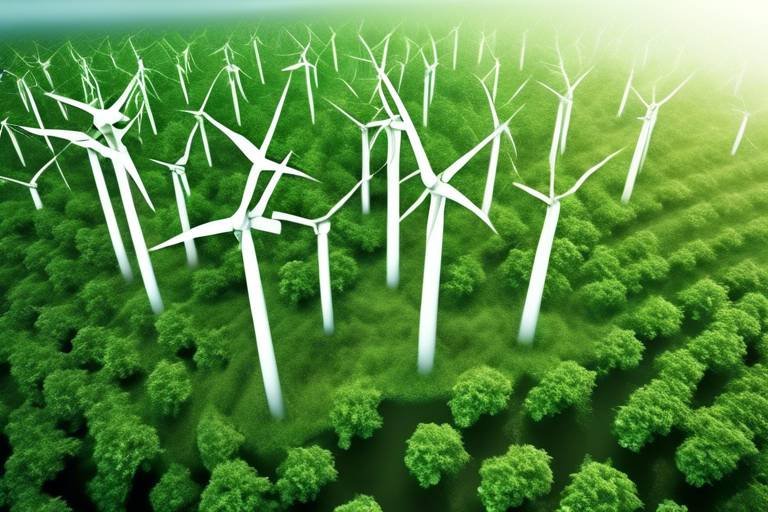Ethical Considerations of Green Energy Solutions
In today's world, where the effects of climate change are becoming increasingly evident, the shift towards green energy solutions is more vital than ever. However, as we embrace renewable energy sources like solar, wind, and hydro, it's essential to consider the ethical implications that accompany this transition. This article delves into various aspects of ethical practices in sustainable energy, focusing on how these solutions impact marginalized communities, the importance of community engagement, and the balance between technological advancements and environmental sustainability.
At the heart of ethical green energy solutions lies the concept of environmental justice. This framework examines how green energy initiatives can either alleviate or exacerbate existing inequalities faced by marginalized communities. Historically, these communities have been disproportionately affected by environmental degradation and pollution, often lacking access to clean energy resources. Therefore, it's crucial that green energy policies are designed to be inclusive, ensuring that everyone has equitable access to benefits derived from renewable energy. By addressing these historical inequalities, we can create a more just and sustainable future for all.
Engaging local communities is vital for the successful implementation of green energy projects. Without their support and involvement, even the most well-designed initiatives can falter. Community engagement fosters trust and enhances project acceptance, paving the way for smoother transitions to renewable energy sources. By involving local populations in decision-making processes, we can ensure that their voices are heard and their needs are met. This approach not only strengthens community ties but also leads to more effective and sustainable energy solutions.
Participatory planning is a method that involves stakeholders right from the planning stages of green energy projects. This means creating platforms where community members can share their insights, concerns, and aspirations. Whether through public meetings, surveys, or workshops, the goal is to ensure that the project designs reflect the community's needs and values. By incorporating local knowledge and preferences, we can create energy solutions that are not only technically sound but also culturally and socially relevant.
Establishing effective feedback mechanisms is essential for maintaining an open dialogue between project developers and the community. These channels allow residents to express their concerns and suggestions regarding energy projects. For instance, online platforms, community forums, and regular town hall meetings can serve as valuable tools for gathering input. Addressing community feedback not only improves project designs but also builds trust and fosters a sense of ownership among residents.
Education and awareness campaigns play a crucial role in empowering communities to engage in discussions about green energy. By disseminating information about the benefits and challenges of renewable energy, we can equip individuals with the knowledge they need to participate meaningfully in decision-making processes. Workshops, informational sessions, and social media campaigns can all contribute to a more informed public, ultimately leading to greater community involvement in energy initiatives.
The transition to green energy solutions can significantly impact local economies. On one hand, the shift towards renewable energy sources can lead to job creation and economic benefits, stimulating growth in sectors such as manufacturing, installation, and maintenance of renewable technologies. On the other hand, communities may face challenges as they transition from traditional energy sources. It's essential to analyze both the opportunities and obstacles that arise during this transition to ensure that local economies can thrive in a sustainable manner.
Finding the right balance between sustainability and technological advancement is another critical ethical consideration in green energy solutions. While emerging technologies can enhance efficiency and reduce costs, they may also pose ethical dilemmas regarding their environmental and social impacts. For instance, the production of solar panels and wind turbines often requires significant resource extraction, raising questions about the sustainability of these practices.
The extraction of resources necessary for green technologies brings forth a host of ethical concerns. This includes the environmental degradation associated with mining and the social implications for communities affected by resource extraction. It's vital to assess the entire lifecycle of renewable energy technologies, ensuring that the benefits outweigh the negative impacts on both the environment and local populations.
Finally, assessing the long-term viability of green energy solutions is crucial for ensuring their sustainability. As we continue to innovate and develop new technologies, we must engage in ongoing ethical reflections about the practices we adopt. This means evaluating whether current methods are truly sustainable and considering alternative approaches that prioritize both environmental health and social equity.
- What is environmental justice in the context of green energy? Environmental justice focuses on ensuring that marginalized communities have equal access to clean energy resources and are not disproportionately affected by environmental harm.
- How can communities engage in green energy projects? Communities can engage through participatory planning, providing feedback, and participating in education and awareness campaigns.
- What are the economic impacts of transitioning to green energy? Transitioning to green energy can create jobs and stimulate local economies, but it may also present challenges that need to be addressed.
- What ethical dilemmas arise from resource extraction for green technologies? Ethical dilemmas include environmental degradation and social injustices faced by communities involved in resource extraction.

Environmental Justice
is a critical concept that addresses the intersection of environmental issues and social equity. It examines how green energy initiatives can impact marginalized communities, ensuring that these groups have equitable access to clean energy resources. For far too long, communities of color and low-income populations have been disproportionately affected by environmental degradation and pollution. Therefore, it is essential to consider historical inequalities when implementing green energy policies.
When we talk about environmental justice, we must recognize that it is not just about providing access to renewable energy; it's about empowering communities to participate in the decision-making processes that affect their lives. This includes understanding the unique needs and challenges faced by these communities, which often lack the resources to advocate for themselves. By prioritizing inclusivity in green energy policies, we can create a more equitable energy landscape that benefits everyone.
For instance, many renewable energy projects, such as solar farms or wind turbines, can significantly alter local landscapes and economies. If these projects are not designed with community input, they may exacerbate existing inequalities rather than alleviate them. This is where the concept of community engagement comes into play. Engaging local populations in the planning and implementation of green energy initiatives ensures that their voices are heard and their needs are met.
Moreover, it is crucial to recognize that environmental justice is not a one-size-fits-all approach. Different communities have different cultural, economic, and environmental contexts, which must be taken into account. For example, a rural community may prioritize energy independence and local job creation, while an urban community may focus on reducing air pollution and improving public health. By tailoring green energy solutions to the specific needs of each community, we can foster a sense of ownership and responsibility towards these initiatives.
In summary, environmental justice is about more than just access to clean energy; it's about creating a fair and inclusive energy system that addresses historical injustices. By ensuring that marginalized communities are involved in the conversation, we can pave the way for a sustainable future that benefits everyone. This is not just an ethical imperative; it is a necessary step towards achieving a truly sustainable energy transition.
- What is environmental justice? Environmental justice is the fair treatment and meaningful involvement of all people in environmental laws, regulations, and policies, ensuring that no group bears a disproportionate share of negative environmental consequences.
- Why is community engagement important in green energy projects? Community engagement ensures that local populations have a voice in decisions that affect their environment and livelihoods, leading to more successful and accepted projects.
- How can we ensure inclusivity in green energy policies? By actively involving marginalized communities in the planning and implementation processes, tailoring solutions to their unique contexts, and providing resources for advocacy and education.

Community Engagement
Community engagement is not just a buzzword; it’s the heartbeat of successful green energy projects. Imagine a world where energy solutions are not imposed from the top down but are collaboratively crafted with the very people they affect. This approach fosters a sense of ownership and trust, which is crucial for any initiative aiming to bring about change. When communities are actively involved in the decision-making process, they are more likely to support and sustain these projects. It's like building a house: if you let the homeowners participate in the design, they will take pride in the structure and care for it long after it's built.
One effective strategy for community engagement is through participatory planning. This method ensures that stakeholders—residents, local businesses, and community leaders—are not just consulted but are integral to the planning stages of green energy projects. By incorporating diverse perspectives, project developers can tailor solutions that meet the unique needs of each community. For instance, in a recent solar farm initiative, engaging local farmers in the planning process led to the design of a dual-use system where crops could grow alongside solar panels, maximizing land utility.
Another critical aspect of community engagement is the establishment of feedback mechanisms. These channels allow residents to voice their concerns and suggestions regarding energy projects. Imagine a town hall meeting where community members can express their thoughts and feel heard. This not only enhances transparency but also builds a rapport between developers and residents. Effective feedback mechanisms can include online surveys, suggestion boxes, or regular community forums. By actively seeking input, project leaders can address potential issues before they escalate, ensuring smoother project implementation.
Moreover, education and awareness campaigns play a vital role in community engagement. When communities are equipped with knowledge about green energy technologies and their benefits, they can engage meaningfully in discussions and decision-making processes. Workshops, informational sessions, and even social media campaigns can serve as platforms for disseminating information. For example, a local initiative in a small town included educational workshops that not only explained the benefits of wind energy but also debunked common myths. This empowered residents to become advocates for the project, transforming skepticism into enthusiasm.
In summary, community engagement is not merely a checkbox in the project planning process; it is essential for the long-term success of green energy initiatives. By fostering participatory planning, establishing robust feedback mechanisms, and prioritizing education, we can create a collaborative environment where communities thrive alongside sustainable energy solutions. After all, when communities feel valued and included, the journey towards a greener future becomes a shared adventure.
- What is community engagement in green energy projects?
Community engagement refers to the active involvement of local residents and stakeholders in the planning, decision-making, and implementation of green energy initiatives. - Why is community engagement important?
It fosters trust, ensures that projects meet local needs, and enhances the likelihood of project acceptance and sustainability. - How can communities provide feedback on energy projects?
Communities can provide feedback through surveys, public meetings, suggestion boxes, and online platforms to express their opinions and suggestions. - What role does education play in community engagement?
Education empowers community members with knowledge about green energy technologies, enabling them to participate meaningfully in discussions and advocate for projects.

Participatory Planning
Participatory planning is a game-changer in the realm of green energy projects. It’s about more than just ticking boxes; it’s about genuinely involving the community in the decision-making process. Imagine a scenario where the voices of local residents shape the energy landscape of their own neighborhoods. Sounds ideal, right? This approach not only fosters a sense of ownership but also ensures that the projects implemented truly reflect the needs and desires of the community.
But how do we make this happen? The first step is to create inclusive forums where community members can come together to discuss their thoughts and concerns. These forums can take various forms, from town hall meetings to online platforms where people can share their opinions at their convenience. By using a mix of traditional and modern communication methods, we can reach a broader audience and encourage participation from diverse demographics.
Another critical element of participatory planning is the use of visual aids. When discussing complex energy projects, visual representations such as maps, charts, and models can help demystify the information. This not only makes it easier for community members to understand the plans but also allows them to visualize how these projects will affect their lives. For instance, a well-placed infographic can illustrate how a new solar farm might impact local wildlife or how wind turbines could alter the landscape.
Furthermore, it’s essential to establish feedback loops that allow community members to voice their opinions throughout the project lifecycle. This can be achieved through surveys, suggestion boxes, or dedicated feedback sessions. When people feel their input is valued and acted upon, it enhances trust between the developers and the community, paving the way for smoother project implementation. A well-structured feedback mechanism can look something like this:
| Feedback Channel | Purpose | Frequency |
|---|---|---|
| Surveys | Collect community opinions | Quarterly |
| Public Meetings | Discuss project updates | Bi-annually |
| Online Forum | Ongoing discussions | Continuous |
Incorporating these elements into the planning process not only enhances the quality of the projects but also builds a stronger community bond. When residents see their ideas reflected in the final outcomes, it cultivates a sense of pride and responsibility towards the project. This is not just about energy; it’s about building a sustainable future together.
Ultimately, participatory planning is about breaking down barriers and fostering collaboration. By engaging with the community from the very beginning, we can create green energy solutions that are not only effective but also ethically sound. It’s a win-win situation that can lead to innovative ideas and a more sustainable world.
- What is participatory planning? Participatory planning is an approach that involves community members in the decision-making process of projects, ensuring their voices and needs are considered.
- Why is community involvement important in green energy projects? Community involvement ensures that the projects are tailored to the local context, increasing acceptance and sustainability.
- How can communities provide feedback on energy projects? Communities can provide feedback through surveys, public meetings, and online forums, allowing them to express their opinions and concerns.
- What are the benefits of using visual aids in planning? Visual aids help simplify complex information, making it easier for community members to understand and engage with the project plans.

Feedback Mechanisms
Feedback mechanisms are an essential component of any successful green energy project. They serve as the bridge between the community and project developers, ensuring that the voices of local residents are not only heard but also valued. Imagine a scenario where a community has a say in how a solar farm is constructed or where wind turbines are placed. This kind of involvement can lead to more tailored solutions that benefit everyone. However, the challenge lies in establishing effective channels for gathering feedback and addressing the concerns of the community.
One of the most effective ways to implement feedback mechanisms is through regular community meetings. These gatherings provide a platform for residents to express their thoughts and concerns directly to project managers and developers. It's not just about listening; it's about creating a dialogue. By fostering an environment where community members feel comfortable sharing their opinions, developers can gain invaluable insights that can guide project modifications. Additionally, these meetings can help build trust, which is crucial for the long-term success of any green initiative.
Another popular method for collecting feedback is through online surveys and digital platforms. In our tech-savvy world, many people prefer to share their thoughts from the comfort of their homes. Online surveys can reach a broader audience and allow for anonymous responses, which can lead to more honest feedback. However, it's important to ensure that these digital tools are accessible to everyone, including those who may not have reliable internet access. This highlights the need for a multi-faceted approach to feedback collection, blending traditional methods with modern technology.
Moreover, establishing a dedicated feedback hotline can be a game-changer. This hotline would allow community members to call in and share their concerns or suggestions at any time. It's a simple yet effective way to ensure that people feel heard, especially those who may not be able to attend meetings or fill out surveys. The key here is to ensure that all feedback is taken seriously and responded to in a timely manner. Transparency is vital; when community members see their input being acted upon, it reinforces their trust in the project.
In addition to these methods, it's crucial to create a feedback loop. This means that after gathering feedback, project developers should communicate back to the community about how their input has influenced project decisions. For instance, if a significant number of residents express concerns about the visual impact of wind turbines, developers can share how they plan to address this issue. This not only demonstrates accountability but also encourages ongoing participation. When community members see that their voices matter, they are more likely to engage in future discussions.
In conclusion, effective feedback mechanisms are not just a checkbox in the project development process; they are the lifeblood of successful green energy initiatives. By prioritizing community input and creating multiple channels for feedback, developers can ensure that their projects are not only environmentally sustainable but also socially responsible. The goal is to create a harmonious relationship between technology and the community, where both can thrive together.
- What are feedback mechanisms in green energy projects?
Feedback mechanisms are systems that allow community members to express their opinions, concerns, and suggestions regarding energy projects. They can include community meetings, online surveys, and dedicated hotlines. - Why is community feedback important?
Community feedback is crucial for ensuring that projects meet the needs and concerns of local residents, fostering trust, and enhancing project acceptance. - How can developers ensure feedback is taken seriously?
Developers can create a feedback loop by communicating back to the community about how their input has influenced project decisions, demonstrating accountability and encouraging ongoing participation. - What methods can be used to gather feedback?
Effective methods include community meetings, online surveys, and feedback hotlines, all tailored to ensure accessibility for all community members.

Education and Awareness
In the rapidly evolving world of green energy, are not just beneficial—they are absolutely essential. Imagine trying to navigate a dense forest without a map; that’s what communities face when they lack information about renewable energy options. By empowering individuals with knowledge, we can transform skepticism into enthusiasm and participation.
Education initiatives can take many forms, from workshops and community meetings to online courses and informational pamphlets. These resources aim to demystify the complex world of renewable energy technologies and policies. For instance, local governments and NGOs can collaborate to create programs that inform citizens about the benefits of solar, wind, and other renewable sources. Such initiatives can help bridge the gap between technical jargon and everyday understanding.
Moreover, awareness campaigns can play a pivotal role in shaping public opinion. When people understand the positive impacts of green energy—such as reduced carbon footprints, lower energy bills, and job creation—they become more likely to support local projects. This support is crucial for the successful implementation of green energy initiatives. Imagine a community rallying together to endorse a solar farm; that’s the power of informed citizens!
To ensure that education reaches all corners of the community, it’s vital to consider diverse learning styles and accessibility. Not everyone learns the same way, and some community members may face barriers to accessing information. Therefore, providing materials in various formats—such as videos, brochures, and interactive online platforms—can help cater to a broader audience. Additionally, incorporating local languages and cultural contexts can enhance understanding and engagement.
Furthermore, it’s important to create a feedback loop where community members can ask questions and express their concerns. This approach not only fosters transparency but also builds trust. People are more likely to engage when they feel their voices are heard. By establishing channels for feedback, such as community forums or dedicated hotlines, energy projects can adapt based on real-time input from the community.
In conclusion, education and awareness are the bedrock of successful green energy transitions. They empower communities to make informed decisions, engage in meaningful discussions, and ultimately support sustainable practices. As we continue to advance towards a greener future, let’s not forget the importance of keeping everyone in the loop. After all, a well-informed community is a powerful ally in the quest for a sustainable world.
- What are the benefits of green energy? Green energy reduces carbon emissions, lowers energy costs, and creates jobs.
- How can communities get involved in green energy projects? Communities can participate through educational programs, public forums, and local government initiatives.
- What role does education play in green energy? Education helps demystify renewable energy technologies and fosters informed public support.
- How can feedback be gathered from the community? Feedback can be collected through surveys, community meetings, and online platforms.

Impact on Local Economies
The transition to green energy solutions is not just an environmental necessity; it also has profound implications for local economies. As communities shift from fossil fuels to renewable resources, they face a unique set of opportunities and challenges that can reshape their economic landscape. For instance, the introduction of solar farms or wind turbines can lead to significant job creation, providing new employment opportunities in installation, maintenance, and operation. According to recent studies, the renewable energy sector has the potential to create millions of jobs globally, which is a promising prospect for local communities struggling with unemployment.
However, the economic benefits of green energy are not universally distributed. It's crucial to recognize that while some regions may thrive, others may experience disruptions. For example, communities heavily reliant on traditional energy sources may face job losses as industries transition. This can lead to economic instability and social unrest if not managed effectively. Therefore, it’s essential for policymakers to implement strategies that not only promote green energy but also support those who may be adversely affected.
In addition to job creation, green energy projects can stimulate local economies through increased investments and infrastructure development. When companies invest in renewable energy projects, they often contribute to local economies by purchasing materials and services from nearby businesses. This creates a ripple effect, leading to enhanced local economic activity. A recent report highlighted that every $1 million invested in renewable energy can generate approximately 5 to 7 jobs in the local economy, significantly boosting economic growth.
| Sector | Job Creation Potential |
|---|---|
| Solar Energy | 3.8 million jobs by 2030 |
| Wind Energy | 1.4 million jobs by 2030 |
| Energy Efficiency | 2.3 million jobs by 2030 |
Moreover, the shift towards green energy can enhance energy independence, reducing reliance on imported fuels and keeping energy dollars within the local economy. This not only strengthens local economies but also fosters community resilience. However, the transition must be approached with care. It’s vital to engage local communities in the planning and implementation of renewable energy projects to ensure that the benefits are equitably distributed.
In summary, the impact of green energy solutions on local economies is multifaceted. While there are significant opportunities for job creation and economic growth, it is essential to address the challenges that may arise during this transition. By fostering inclusive policies and engaging communities, we can ensure that the shift towards renewable energy not only protects our planet but also enhances the livelihoods of those who call it home.
- What are the main benefits of green energy for local economies?
The main benefits include job creation, increased investments, and enhanced energy independence, which can lead to greater economic stability. - How can communities prepare for the transition to green energy?
Communities can prepare by engaging in participatory planning, advocating for inclusive policies, and investing in education and training programs to equip the workforce for new job opportunities. - What challenges might arise during the transition?
Challenges may include job losses in traditional energy sectors, economic instability in affected communities, and the need for significant investment in new infrastructure.

Sustainability vs. Technology
In the ever-evolving landscape of green energy, the interplay between sustainability and technology becomes a fascinating yet complex dance. On one hand, we have the pressing need for sustainable solutions that respect our planet's limits, while on the other, the relentless march of technology promises innovative ways to harness energy. But how do we ensure that these advancements do not compromise our ethical obligations to the environment and society? This question is at the heart of the debate surrounding ethical green energy solutions.
To truly grasp this balance, we must first understand that sustainability is not merely a buzzword; it’s a commitment to maintaining ecological integrity for future generations. Conversely, technology, while a powerful tool for achieving sustainability, can sometimes lead us down a path of exploitation and unintended consequences. For example, the extraction of rare earth metals used in solar panels and wind turbines poses significant environmental and social challenges. This raises an ethical dilemma: are we trading one form of environmental degradation for another?
Moreover, the rapid advancement of technology often outpaces our ability to regulate and assess its impact. As we embrace new energy solutions, we need to ask ourselves critical questions: Are we prioritizing short-term gains over long-term sustainability? Are we considering the full life cycle of the technology we implement? These questions highlight the importance of a holistic approach that integrates ethical considerations into the development and deployment of renewable energy technologies.
One way to navigate these waters is through a framework that emphasizes ethical reflection at every stage of the energy project lifecycle. This could involve:
- Conducting thorough environmental impact assessments
- Engaging with local communities to understand their needs and concerns
- Implementing transparent supply chains that prioritize ethical sourcing
Furthermore, we must recognize that technology should serve as a means to enhance sustainability, not as a substitute for it. For instance, advancements in energy storage and grid management can optimize the use of renewable resources, making them more reliable and efficient. However, if these technologies rely on unsustainable practices or materials, we risk perpetuating the very problems we aim to solve. Thus, the challenge lies in ensuring that our technological innovations are aligned with our sustainability goals.
As we look to the future, the question remains: how can we create a synergy between sustainability and technology? The answer lies in fostering a culture of innovation that prioritizes ethical considerations, encourages community involvement, and advocates for responsible resource management. By doing so, we can pave the way for a future where technology enhances our ability to live sustainably, rather than undermining it.
- What is the main ethical concern regarding technology in green energy?
The primary concern is the potential for environmental degradation and social injustice that can arise from resource extraction and technological implementation. - How can communities be involved in green technology decisions?
Communities can participate through feedback mechanisms, participatory planning, and educational initiatives that empower them to voice their opinions and concerns. - What role does education play in balancing sustainability and technology?
Education equips communities with the knowledge to engage in discussions about green energy solutions, ensuring that they understand both the benefits and the potential drawbacks of new technologies.

Resource Extraction Ethics
When we talk about green energy, it’s easy to get swept away by the promise of a cleaner, more sustainable future. However, lurking beneath the surface is a complex web of ethical dilemmas, particularly surrounding resource extraction. The materials needed for renewable technologies—like solar panels, wind turbines, and batteries—often come from resource-intensive processes that can have devastating impacts on both the environment and local communities. It's a bit like trying to bake a cake while ignoring the mess you make in the kitchen; you might end up with something sweet, but at what cost?
First, let’s consider the environmental impact of resource extraction. Mining for materials such as lithium, cobalt, and rare earth metals can lead to significant ecological degradation. This includes deforestation, loss of biodiversity, and water pollution. For instance, the extraction of lithium for batteries often involves large amounts of water, which can deplete local water sources and harm agricultural practices. In many cases, these activities disproportionately affect marginalized communities who rely on these ecosystems for their livelihoods. It raises an important question: can we truly call ourselves "green" if our solutions come at the expense of the planet and its people?
Moreover, the social implications of resource extraction cannot be overlooked. Many mining operations are located in developing countries, where regulations may be lax and labor rights often ignored. Workers may face unsafe conditions, and local populations may be displaced without proper compensation. This situation creates a cycle of inequality that contradicts the very principles of sustainability and justice that green energy advocates promote. It’s crucial that as we pursue renewable energy solutions, we also advocate for ethical sourcing practices that respect human rights and promote fair labor conditions.
To address these ethical concerns, we must engage in a thorough evaluation of our sourcing practices. This involves not just looking at the materials we extract, but also considering how they are extracted. Ethical frameworks should be established that prioritize sustainable practices and community rights. For instance, companies could adopt transparency measures that disclose their supply chains and the environmental impacts of their operations. By doing so, consumers can make informed choices, supporting brands that align with their values.
In addition to ethical sourcing, we need to think about the long-term implications of our energy choices. The lifecycle of renewable technologies—from extraction to disposal—should be considered holistically. For example, what happens to solar panels at the end of their life? Are they recycled responsibly, or do they end up in landfills, creating new environmental issues? Addressing these questions is essential for ensuring that our green energy solutions are truly sustainable.
In conclusion, the ethics of resource extraction in the green energy sector demand our attention. As we embrace renewable technologies, we must also commit to ethical practices that protect both the environment and the communities affected by our choices. It’s a delicate balance, but one that is essential for achieving a future where green energy truly means a cleaner, fairer world for everyone.
- What are the main ethical concerns regarding resource extraction for green energy? The primary concerns include environmental degradation, social injustice, and labor rights violations associated with the mining of materials needed for renewable technologies.
- How can companies ensure ethical sourcing of materials? Companies can adopt transparency measures, engage with local communities, and adhere to strict environmental and labor standards throughout their supply chains.
- What role do consumers play in promoting ethical practices in green energy? Consumers can make informed choices by supporting brands that prioritize ethical sourcing and sustainable practices, thus driving demand for responsible products.
- Are there alternatives to traditional resource extraction methods? Yes, innovations such as recycling existing materials and developing new technologies that require fewer or alternative resources are being explored to reduce the environmental impact.

Long-term Viability
The concept of in green energy solutions is not just a buzzword—it's a critical consideration that can determine the success or failure of these initiatives. As we shift towards renewable energy sources, it’s essential to ask ourselves: are these solutions sustainable in the long run? Will they continue to provide benefits to both the environment and society, or are we merely trading one set of problems for another? To navigate this complex landscape, we must evaluate the sustainability of current practices and remain vigilant about the ethical implications of our choices.
One key aspect of long-term viability is the assessment of current technologies. While solar panels and wind turbines are often celebrated for their low emissions, the materials used in their production can pose significant environmental challenges. For instance, the extraction of rare earth metals necessary for batteries and other components can lead to habitat destruction and pollution. Therefore, it’s crucial to consider the entire lifecycle of these technologies, from resource extraction to disposal. A comprehensive understanding can help us identify potential pitfalls and innovate solutions that minimize negative impacts.
Moreover, the economic feasibility of green energy projects is another vital factor. While initial investments in renewable energy can be high, they often pay off in the long run through lower operational costs and reduced reliance on fossil fuels. However, communities must be prepared for the transitional phase, which can be economically challenging. For instance, areas heavily reliant on coal mining may face job losses as they switch to cleaner energy sources. This brings us to the importance of developing strategies for workforce transition, ensuring that workers are retrained and supported through this shift.
In addition to economic factors, we must also consider the social dimensions of long-term viability. Engaging communities in the planning and implementation of green energy projects fosters a sense of ownership and responsibility. When people feel connected to the energy solutions in their area, they are more likely to support and maintain these systems. This community involvement can be achieved through transparent communication and participatory planning processes, ensuring that local voices are heard and valued.
As we look to the future, it’s essential to remember that the journey towards sustainable energy is ongoing. Continuous ethical reflection is necessary to adapt our strategies as new technologies emerge and societal needs evolve. This means regularly revisiting our goals, assessing our impacts, and being willing to pivot when necessary. By committing to this adaptive approach, we can enhance the long-term viability of green energy solutions, ensuring they serve not just the present, but also future generations.
- What are the main challenges to the long-term viability of green energy solutions?
Challenges include resource extraction ethics, economic feasibility during transition phases, and the need for continuous community engagement and support.
- How can communities ensure they benefit from green energy projects?
By actively participating in project planning, demanding transparency, and advocating for job training programs, communities can secure economic and social benefits.
- Why is ethical reflection important in green energy development?
Ethical reflection helps identify and mitigate potential negative impacts of new technologies, ensuring that solutions are sustainable and equitable for all stakeholders.
Frequently Asked Questions
- What is environmental justice in the context of green energy?
Environmental justice focuses on ensuring that all communities, especially marginalized ones, have equitable access to clean energy resources. It addresses historical inequalities and aims to include diverse voices in the development of green energy initiatives.
- How can communities engage in green energy projects?
Community engagement is vital for the success of green energy projects. Involving local populations in decision-making processes, fostering trust, and enhancing project acceptance are key strategies. This can include participatory planning, feedback mechanisms, and educational campaigns.
- What is participatory planning?
Participatory planning is a process that involves stakeholders, including community members, in the early stages of planning green energy projects. This ensures that their voices are heard and their needs are incorporated into project designs, leading to more successful and accepted initiatives.
- What are feedback mechanisms, and why are they important?
Feedback mechanisms provide channels for communities to express their concerns and suggestions regarding energy projects. They are crucial for addressing community input and ensuring that projects align with local needs and expectations.
- How does education and awareness impact community involvement in green energy?
Education and awareness campaigns empower communities by providing them with the knowledge needed to engage in discussions about green energy. Informed participation leads to better decision-making and fosters a sense of ownership over local energy solutions.
- What is the impact of green energy solutions on local economies?
Green energy solutions can significantly impact local economies by creating jobs and providing economic benefits. However, communities may also face challenges during the transition to renewable energy sources, which need to be carefully managed.
- How do we balance sustainability with technological advancement?
Balancing sustainability with technological advancement involves addressing ethical dilemmas that arise from emerging technologies in the renewable energy sector. Continuous reflection on the environmental and social impacts of these technologies is essential for ethical practices.
- What are the ethical concerns regarding resource extraction for green technologies?
Resource extraction for green technologies raises ethical concerns related to environmental degradation and social implications. It's important to consider the sustainability of sourcing materials and the impacts on local communities and ecosystems.
- Why is assessing the long-term viability of green energy solutions important?
Assessing the long-term viability of green energy solutions is crucial to ensure that current practices are sustainable. This evaluation helps identify areas for improvement and promotes continuous ethical reflection in energy development.



















